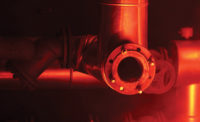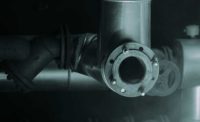Famous mathematician Edward Lorenz coined the phrase “The Butterfly Effect,” which is the belief that some small occurrence could create devastating results in another location far away. It theorizes a hurricane could be caused by the flapping of a butterfly’s wings days or weeks earlier thousands of miles away. This theory always made me think of low-pressure steam systems. A small change or adjustment in one part of the system can affect other parts of the steam system. For example, a local school district had a classroom that would not heat. By the time I arrived, they had replaced the steam trap twice and the control valve once. We found the cause and solution to the problem three stories below, in a crawlspace. The asbestos abatement company removed the pipe hanger on the condensate pipe in the crawlspace and never reconnected it. The abatement crew crawled over the pipe, causing it to sag, which created a water seal. This affected the breathing of the system. Once the pipe was raised and the hanger reattached, the room heated normally.
Understanding Steam Systems
An easy way to understand steam system operation is to think about differential pressure. Pressure goes from high to low, always. Steam system operation is based on ounces of pressure differential, and a small difference in pressure could change the dynamics of the system. For example, if two boilers are connected with a common equalizing pipe, a one-ounce difference in steam pressure between two boilers could mean a water level difference of 1.75 in between the boilers.
One of the basic tenets of steam systems is this: two gases (steam and air) cannot occupy the same space. When a steam system is off, the piping and part of the boiler is filled with air. On a call for heat, the burner starts, and soon the water inside the boiler is heated enough to become steam. When water becomes steam, it will expand at 1,600 its volume. This volume of steam pushes the air out of the boiler and into the pipes. As the steam expands with the heat, the steam zooms out of the boiler at speeds between 20 to 40 miles per hour, pushing the air ahead of it. The air is vented out of the piping through the steam traps and out the vents on the boiler feed or condensate tank.
At the end of the heating cycle, the burner shuts off, the steam starts to collapse, and the volume of space that was filled with steam suddenly is empty. Since there is not steam, air rushes in to take the place of the steam. Anything that interrupts this cycle will cause issues with the operation. This could be sagging pipes, defective steam traps, or control valves. I like to think the steam system breathes, and the boiler exhales steam and then inhales air. The following are the top problems I see on steam boiler replacement projects.
Sizing
Unlike hydronic systems, steam systems are sized according to the connected load. The connected load includes all the piping, radiators, coils, and heat emitters. The sizing calculation was to assure 70ºF room temperature at the outdoor design temperature. How did the customer know whether the installer calculated the sizing properly? After all, most boilers are installed in the summer, and the installer would like to be paid.
There used to be a test on new steam boiler installations. The installer would operate the boiler until the building reached a certain predetermined indoor temperature based on the outside air temperature. For example, if the outside air temperature was 50ºF, the installer would have to operate the boiler until the interior building temperature reached 104.8ºF. If the outside air temperature was 70ºF, the boiler would have to heat the building to 118.7ºF. I am so glad they do not do that test any longer. Sizing is critical with steam systems. An undersized steam boiler will never heat the building properly. The radiators closest to the boiler will heat, but the far ones would not. An oversized boiler can short cycle leading to unbalanced heating in the building. In addition, if the boiler is used for a process application, the short-cycling could affect the temperature of the steam.
Near Boiler Piping
You probably realize this, but the new steam boilers are much smaller than the old ones. The old boilers had large internal steam chests, which would dry the steam before it was dispatched to the system. The new boilers use the near boiler piping to dry the steam. The near boiler piping is the piping directly attached to the boiler. Be sure to follow the manufacturer’s instructions. The newer boilers are typically designed around 40 ft/sec. Excess velocity will allow steam carryover and lower system efficiency. Many cast iron steam boilers require extra piping, called a swing joint, which is used to absorb the expansion and contraction of the piping.
Carryover inside a steam system can adversely affect steam quality. Carryover is when water inside the steam boiler becomes entrained in the steam and goes out into the system. The water causes numerous problems, such as causing the steam to condense before it reaches the radiators. It also increases the water treatment chemical treatment use.
System Piping
I was taught to use schedule 40 pipe for the steam piping and schedule 80 pipe, which is 50% thicker, for the condensate piping. The thicker condensate piping is used because of the carbonic acid formed inside the condensate piping when carbon dioxide mixes with water.
During my apprenticeship, I was told to never use copper tubing for a steam system and was recently asked about it in a class I taught. The person reminded me copper is used for high-pressure refrigerants. The question piqued my interest, and my research found a site for the Copper Development Association, which claims copper can be used for steam systems. It references the ASME Boiler and Pressure Vessel Code, which states copper tubing and fittings can be used for temperatures up to 400ºF and pressures up to 120 psig, easily within the parameters of a low-pressure steam system. Another new development is pipe press fittings are now available for use on steam systems, which will lower installation time.
Pipe Pitch
Steam piping is usually pitched at a rate of .25-in to .50-in for every 10 ft away from the boiler. This is to allow the condensate to move and not pool. If condensate pools, the steam travelling at speeds up to 60 miles per hour will pick up the water and slam it into the closest fitting. Condensate-induced water hammer could occur when the cool water pooled inside a pipe cools the steam causing it to rapidly collapse. This dangerous condition can create pressures in excess of 1,500 psig.
Pressure Control Settings
Ever since December 1899, low-pressure comfort steam systems used 2 Psig as the design steam pressure. Steam to water heat exchangers may use slightly higher steam pressures. Boiler steam pressures over 7 psig can create mayhem in the system. It will lead to elevated condensate temperatures which will flash to steam. In addition, the condensate piping, sized for mostly condensate, will be undersized because of the vapor and impede the flow back to the boiler feed unit.
This steam also raises the temperature of the condensate water inside the tank which affects the feedwater pump to the boiler. Many of the feedwater pumps are designed to handle temperatures below 200ºF. In addition, the steam vapor will be vented out the tank vent and wasted. This will increase the makeup water and chemical treatment costs.
Pipe Insulation
Steam pipe insulation is required to assure dry steam is delivered throughout the building. If the insulation is missing, the steam could condense prematurely and lower the system efficiency. In addition, the extra condensate could overwhelm the steam trap because it was sized to handle condensate from an insulated pipe. This could lead to a stalled trap which will cause banging from water hammer and unbalanced steam distribution.
Another consideration is that an uninsulated steam pipe loses 80 times more heat than an insulated pipe, which could make the room very warm. Industry expert Dan Holohan suggests insulating the condensate pipes to reduce the formation of carbonic acids generated in the condensate piping.
Insulate boiler feed tank?
This may be a bit tricky, and I suggest you contact the tank manufacturer before insulating it. While insulation will slow the heat loss of the tank into the boiler room, there may be some unintended consequences. According to Xylem/Hoffman Pump, tank insulation may allow excess condensate temperatures, which could affect the pump operation. Insulation could impede access to the tank and could trap moisture against the tank allowing rust to form on the tank.
Water Treatment
Treatment is crucial for steam boilers to maximize equipment life. I have seen boilers fail after only a few years because the water treatment was not done. Treatment will also maintain the original efficiency of the system. If the steam system loses water and must make up fresh water, this new water will have solids that will adhere to the boiler heating surfaces, causing scale and reducing the heat transfer ability. In addition, the fresh water will have oxygen which will pit the inside of the boiler and piping. Most water treatment programs incorporate an oxygen scavenger in the treatment. This will absorb the excess oxygen inside the boiler water. Consult a competent water treatment professional.
Where to feed the treatment?
The treatment is usually piped into the boiler feed tank. However, some boiler feed manufacturers will void the warranty if the treatment chemicals are fed directly to the boiler feed tank and treatment should be injected in another location. Be sure to contact the tank manufacturer for the proper placement of the chemical feed.
Venting the boilers
Most low-pressure steam boilers are Category 1 appliances and vented into a traditional flue or chimney. Verify the size and integrity of the flue before connecting the new boiler. There are a couple caveats on venting the boiler. The International Fuel Gas Code 2012 503.10.8 requires the maximum horizontal length of the flue connector shall be no more than 75% of the height of the vertical chimney or stack unless it is B vent and the horizontal connector can be the same length as the height of the chimney. If the chimney height is over 30 ft high, a draft control should be installed. Excess draft can cause over-firing of the boiler, which will lead to carryover and overfiring.
How Draft Affects the Boiler
We were called to a steam boiler project experiencing several heating problems — most notably, the boiler was going off on low water. When we arrived, the angry customer had a litany of “experts” there and each offered an opinion about the solution. I hate being blindsided when walking onto a job. When something like that happens, I go back to the basics and check all the readings. The water treatment readings showed carryover, and the gas pressure to the burner was slightly less than the gas pressure setting. I find answers come to me while simply watching the boiler operate.
Water was pouring down the top of the boiler gauge glass, which meant the water inside the boiler was surging. This surging is like a tsunami inside the boiler causing the water to rock back and forth. I knelt and viewed the burner flame. The flame was being sucked up inside the boiler, indicating that it was over firing. The next test was the draft on the boiler, which was designed for -0.05-in W.C. The reading showed a draft reading of -0.5-in W.C., ten times the normal level. The excessive chimney draft caused the carryover and the excess water overwhelmed the steam traps, causing them to stall. In addition, the carryover caused water hammer, which would scare the occupants of the building. The surging inside the boiler also caused the low-water cutoff to trip. Once the draft was adjusted, these problems went away.
Control Valves
Zone or radiator control valves could cause some headaches if improperly installed. As stated earlier, the system will either have steam or air in the pipes depending on whether the boiler is on or off. A closed valve could allow a vacuum to form in the piping. Vacuum inside a steam system can do strange things and create havoc. On one project, steam zone control valves were installed to lower the fuel usage. When the valves shut off, it isolated the steam side of the system from the condensate side. When the steam condensed, it pulled the boiler and steam piping into a vacuum. This vacuum pulled the water from the condensate tank into the boiler and flooded it. When the valves opened, it sounded like a Blue Man Group concert with all the banging. A simple vacuum breaker solved the problem.
Good Intentions
A customer hired a new maintenance person who took it upon himself to pipe all the boiler blowdown piping in his penthouse boiler room to the floor drain. He did not like the water spilling on the floor. In a short time, the hot condensate blowdown melted the building pvc drain piping making it look like cooked spaghetti. The owner had to replace much of the drain piping which was conveniently located behind walls and cabinets. The International Plumbing Code 701.7 states the boiler blow off temperature entering the building drain must be below 1,400ºF. For this reason, a blow down tank or cooler is installed.
Steam Traps
The average life of steam traps is between six and 10 years, and I would hazard a guess that the traps in the building you are working on are older than that. I recommend replacing or rebuilding every trap in the building when replacing the boiler. There are rebuild kits available that allow you to simply remove the lid and switch the internal cage unit.
Who does the Maintenance?
A properly designed steam system can last several decades, or it can be ruined within a few years. The deciding factor is the boiler maintenance. A steam system requires more maintenance than a hydronic boiler. If ignored, the steam system will self-destruct rapidly. The manufacturer will inform you of the tasks required to keep the boiler running properly. The lack of or improper maintenance is the leading cause of steam boiler failures.
The angry customer had a litany of “experts” there, and each offered an opinion. I hate being blindsided when walking onto a job. When something like that happens, I go back to the basics and check all the readings. The water treatment readings showed carryover, and the gas pressure to the burner was slightly less than the gas pressure setting. I find answers come to me while simply watching the boiler operate.
When the valves shut off, it isolated the steam side of the system from the condensate side. When the steam condensed, it pulled the boiler and steam piping into a vacuum. This vacuum pulled the water from the condensate tank into the boiler and flooded it. When the valves opened, it sounded like a Blue Man Group concert with all the banging. A simple vacuum breaker solved the problem.
The average life of steam traps is between six and 10 years, and I would hazard a guess that the traps in the building you are working on are older than that. I recommend replacing or rebuilding every trap in the building when replacing the boiler. There are rebuild kits available that allow you to simply remove the lid and switch the internal cage unit. ES





